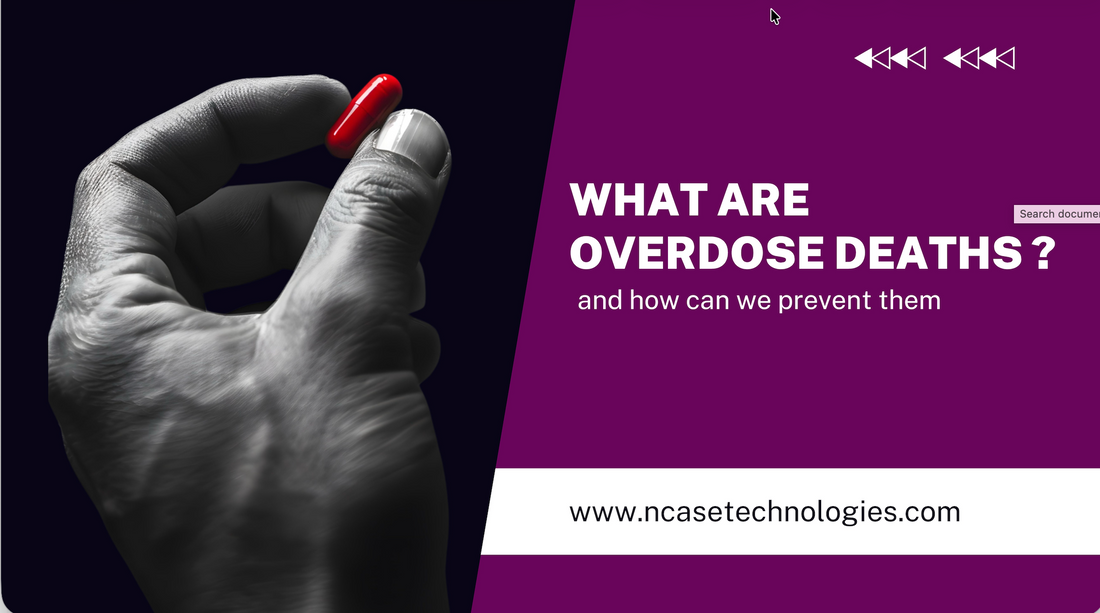
What Are Overdose Deaths and How Can We Prevent Them
Share
The United States is in the middle of a crisis that touches every community: opioid overdoses and overdose deaths. Every single day, thousands of people experience an overdose, and hundreds of them do not survive. The difference between an overdose and an overdose death is critical. An overdose happens when someone takes more of a drug than their body can safely handle. Sometimes the body recovers, sometimes emergency help arrives in time, and sometimes it doesn’t – which is when an overdose becomes fatal.
Opioid overdoses are a specific and especially dangerous type of overdose. Unlike stimulants or alcohol, opioids such as fentanyl, heroin, oxycodone, and hydrocodone depress the central nervous system. They slow breathing and can stop it altogether, leading to unconsciousness, brain injury, and death in a matter of minutes if naloxone or other intervention isn’t given. This is why opioid overdoses are the leading driver of drug-related fatalities in the U.S.
Another layer of complexity is fentanyl poisoning. Many people who die from fentanyl never intended to take opioids at all – they may have used cocaine, counterfeit pills, or MDMA laced with fentanyl. In these cases, the event is not just an “overdose” in the traditional sense, but an unintentional poisoning that blindsides people who weren’t aware they were consuming opioids.
This distinction matters. Talking about “overdoses” in general blurs together different drugs, different risks, and different outcomes. Opioid overdoses, overdose deaths, and fentanyl poisonings are connected – but they are not the same thing. Understanding those differences is the first step toward saving lives.
In this blog, we’ll break down what an overdose is, why opioid overdoses are uniquely deadly, what makes fentanyl so dangerous, and most importantly, how prevention and rapid response with tools like naloxone can turn the tide of the opioid crisis.
What Is an Overdose?
At its core, an overdose happens when a person takes more of a drug than their body can process safely. The substance overwhelms the body’s normal systems, creating toxic effects that range from uncomfortable to life-threatening. In some cases, the body may recover on its own or with medical intervention. In other cases, the damage is too great, and the result is death.
An overdose is not limited to opioids – it can happen with almost any drug, including prescription medications, alcohol, or stimulants. But the way an overdose looks, and how dangerous it becomes, depends on the type of substance involved:
-
Opioids (like heroin, fentanyl, oxycodone, or morphine) slow the central nervous system. They reduce breathing and heart rate. In high doses, breathing can stop entirely, leading to unconsciousness, brain injury, and death if help doesn’t arrive fast enough.
-
Stimulants (like cocaine, methamphetamine, or MDMA) have the opposite effect. They push the body into overdrive, which can trigger seizures, strokes, heart attacks, or severe agitation and paranoia.
-
Alcohol can overwhelm the body through alcohol poisoning. Signs include vomiting, dangerously slow breathing, lowered body temperature, and coma.
Because overdoses affect different systems in different ways, not every overdose is fatal. Many people survive overdoses – sometimes with long-term health consequences, sometimes without. But when the body’s systems can no longer fight back, and vital functions like breathing or heartbeat fail, an overdose crosses into an overdose death. This is why recognizing the early warning signs is so important.
Signs of an Opioid Overdose
Opioid overdoses are especially deadly because they strike at breathing and consciousness. The signs are often visible, and learning to spot them quickly can save a life. Common symptoms include:
-
Extreme drowsiness or inability to stay awake
-
Confusion, disorientation, or inability to think clearly
-
Very slow, weak, or irregular breathing – or no breathing at all
-
Limp body, loss of motor control, or difficulty walking
-
Pupils that appear very small and “pinpoint” in size (not dilated)
-
Pale, blue, or cold skin, especially around the lips and fingertips
If someone shows these symptoms, they may be experiencing an opioid overdose. Immediate action is critical: call emergency services, administer naloxone if available, and stay with the person until help arrives. Every second counts – fast recognition and response often make the difference between survival and death.
Statistics of Overdose Deaths
According to the Centers for Disease Control and Prevention (CDC), drug overdose deaths remain one of the leading public health crises in the United States.
-
In 2023, there were approximately 105,000 drug overdose deaths across the country.
-
Nearly 80,000 of those deaths involved opioids, meaning opioids were responsible for about three out of every four overdose fatalities.
-
Provisional CDC data shows that overdose deaths declined in 2024, with an estimated 80,391 deaths nationwide— down from more than 110,000 in 2023.
-
Deaths specifically linked to opioids also fell, from about 83,140 opioid-involved deaths in 2023 to roughly 54,743 in 2024.
While the overall numbers are still devastating, this recent decline may signal that expanded access to naloxone, public health awareness campaigns, and community prevention programs are beginning to make an impact. However, opioids – especially fentanyl – continue to drive the majority of overdose deaths in the United States.
Now, let's talk about the opioid crisis as a whole.
The Opioid Crisis
What is the Opioid Crisis?
The term “opioid crisis” describes the devastating wave of addiction, overdoses, and overdose deaths linked to opioids – a class of drugs that includes prescription painkillers (like oxycodone and hydrocodone), illicit opioids (like heroin), and powerful synthetic opioids (like fentanyl). What makes the crisis so severe is not just the widespread misuse of these drugs, but the staggering number of deaths they continue to cause year after year.
How the Opioid Crisis Began
The roots of the crisis trace back to the late 1990s and early 2000s, when pharmaceutical companies like Purdue Pharma heavily marketed prescription opioids to doctors. These companies claimed the drugs were safe and non-addictive, which led to widespread prescribing for chronic pain. As prescriptions increased, so did dependence and misuse. Many people who were prescribed opioids developed addictions, and when prescriptions ran out or became too expensive, some turned to heroin or counterfeit pills.
The Role of Fentanyl
The crisis deepened with the rise of fentanyl, a synthetic opioid that is 50 to 100 times stronger than morphine. Fentanyl is now the leading driver of overdose deaths in the United States. It is frequently mixed into street drugs like cocaine, meth, or counterfeit pills, often without the user knowing. This has fueled a surge in fentanyl poisonings – deaths that occur not because someone chose opioids, but because fentanyl was hidden in other substances.
The Crisis Today
Despite growing awareness, the opioid crisis remains one of the most urgent public health challenges of our time. Tens of thousands of Americans die each year from opioid overdoses, with fentanyl involved in the majority of cases. At the same time, prevention programs, harm reduction strategies, and the widespread distribution of naloxone (Narcan) are showing progress. Communities that increase access to treatment and overdose reversal medications are beginning to see declines in deaths, even as the crisis continues to affect families in every corner of the country.
How Do We Prevent Overdose Deaths?
The most important fact to remember is this: overdose deaths are preventable. While not every overdose can be stopped, many lives are saved each year through education, safe practices, and timely intervention. Prevention works on three levels – personal, household, and community.
Personal Strategies to Reduce Overdose Risk
-
Do not mix substances with alcohol. Alcohol can magnify the effects of other drugs, especially opioids, by slowing breathing and impairing judgment. Combining alcohol with opioids, benzodiazepines, or other depressants is one of the most common pathways to fatal overdose.
-
Follow prescriptions exactly as directed. If you are prescribed pain medication, always take it according to your doctor’s instructions. Misusing prescriptions – by taking larger doses, mixing them with other substances, or using them more often than prescribed – can quickly escalate into an overdose.
-
Avoid street drugs. Street drugs are often cut with unknown and unsafe substances. Today, fentanyl contamination is the biggest threat, showing up not only in heroin but also in counterfeit pills, cocaine, and MDMA. Because fentanyl is so strong, even a small amount can cause sudden overdose and death.
-
Understand tolerance. Regular drug use changes how your body responds. When tolerance builds, you may feel the urge to take more to achieve the same effect. But increasing dosage raises the risk of overwhelming the body and triggering an overdose. People who stop using for a while and then return to their old dose are also at high risk, since tolerance can drop quickly.
-
Know the warning signs of an overdose. Trouble breathing, confusion, extreme drowsiness, and loss of consciousness are clear red flags. Recognizing these signs early can be the difference between survival and tragedy.
-
Carry naloxone. Naloxone (brand name Narcan) is a safe, fast-acting medication that reverses the effects of an opioid overdose. It can restore breathing within minutes and save a life. Many states allow you to purchase it without a prescription, and community programs often distribute it for free.
Preventing Overdose at Home
-
Store medicines securely. Keep prescription medications in a locked cabinet or other safe place, away from children, teenagers, or anyone who might misuse them. Even a single pill or dose can be dangerous in the wrong hands.
-
Dispose of unused prescriptions properly. Don’t keep leftover painkillers “just in case.” Unused medications can be misused by family members, friends, or visitors. Most pharmacies and community centers offer safe disposal bins or drug take-back programs.
-
Keep naloxone at home. If someone in your household uses opioids – whether prescribed or otherwise – having naloxone on hand could save their life. Make sure family members know where it is stored and how to use it in an emergency.
Community-Level Prevention
-
Support awareness campaigns. Public education helps reduce stigma, normalize naloxone carriage, and ensure people know what to do when they see an overdose.
-
Expand access to treatment. Medication-assisted treatment (like buprenorphine or methadone), counseling, and rehab programs give people the tools to recover and reduce the cycle of overdose.
-
Advocate for better health policies. Policies that prioritize harm reduction, fund naloxone distribution, and support addiction treatment save lives on a large scale.
Preventing overdose deaths is not only about individual choices – it’s about creating safer environments, better policies, and stronger support systems. Every step, from locking up medications at home to carrying naloxone in your pocket, adds up to lives saved.
Naloxone: The Life-Saving Drug
When it comes to reversing an opioid overdose, naloxone is the single most important tool we have. Naloxone (brand name Narcan) is a medication that rapidly reverses the effects of opioids. It works by binding to the same receptors in the brain that opioids attach to, blocking their effects and restoring normal breathing within minutes.
Unlike many emergency medicines, naloxone is safe, easy to use, and non-addictive. It has no effect if opioids are not in someone’s system, which means it can be given even if you aren’t completely sure the person has overdosed. Its safety profile is why public health officials urge people at risk – and their families and friends – to keep naloxone on hand.
Naloxone Availability
Access to naloxone has expanded significantly in recent years. In most U.S. states, you can get naloxone without a prescription. Pharmacies, community health organizations, harm reduction programs, and even schools often distribute it for free or at low cost. This broad availability is saving thousands of lives every year.
Some states have also passed standing orders, meaning a single doctor’s authorization allows any pharmacy to dispense naloxone to anyone who asks. Community groups are increasingly providing naloxone kits along with training on how to recognize an overdose and administer the medication.
Opioid Prevention Programs
Naloxone alone cannot solve the opioid crisis – but combined with prevention and education, it is a cornerstone of harm reduction. Community programs that teach people how to spot an overdose, how to administer naloxone, and how to reduce risky drug use behaviors are making a measurable difference. These programs help break stigma, empower communities, and most importantly, save lives before emergency responders arrive.
Managing an Overdose Situation
If you suspect someone is experiencing an overdose, immediate action is critical. Every second counts, and knowing what to do can mean the difference between life and death.
Steps to take during a suspected overdose:
-
Call emergency services immediately. Dial 911 and report a possible overdose.
-
Check responsiveness and breathing. If the person is not breathing or breathing very slowly, it is a medical emergency.
-
Administer naloxone. If you have a naloxone kit (spray or injection), use it right away. Repeat if necessary after 2–3 minutes if there is no improvement.
-
Ensure their safety. If the person is unconscious but still breathing, place them on their side in the recovery position to prevent choking.
-
Stay with them. Continue monitoring until help arrives. If their breathing stops, begin rescue breathing or CPR if you are trained to do so.
Acting quickly and decisively gives a person the best possible chance of survival. Even after naloxone is given, they still need medical care, since opioids can outlast naloxone’s effects and cause symptoms to return once it wears off.
Conclusion
Behind every statistic on overdose deaths is a person — a son or daughter, a parent, a sibling, a friend, a neighbor. These are not just numbers in a report, but real lives lost too soon, leaving families and communities in grief. The scale of drug overdoses, especially those involving opioids, is a stark reminder of how urgent this crisis remains.
The good news is that prevention is possible. Education, awareness, and preparedness can make the difference. Recognizing the signs of an overdose, carrying naloxone, and supporting community prevention programs all help reduce risk. On a broader level, breaking stigma, expanding treatment options, and pushing for policies that prioritize harm reduction can shift the momentum of this crisis.
Every small act matters — a conversation, an intervention, a naloxone kit in the right hands. Together, these ripple effects add up to lives saved. By acting with urgency and compassion, we can work toward a safer future where fewer families endure the tragedy of losing a loved one to an overdose.
FAQs
1. What are 5 signs of an opioid overdose?
Slow or stopped breathing, extreme drowsiness or unconsciousness, pinpoint pupils, limp body, and pale or blue lips and skin.
2. How can I prevent an overdose at home?
Store medicines securely, never mix drugs with alcohol, dispose of unused prescriptions properly, keep naloxone available, and educate family members on the warning signs.
3. What drug can reverse an opioid overdose?
Naloxone (brand name Narcan) is the life-saving medication that quickly reverses opioid overdose by restoring normal breathing.
4. What should I do if I suspect someone is overdosing?
Call emergency services immediately, administer naloxone if available, check their breathing, place them in the recovery position if unconscious, and stay with them until help arrives.
5. What is the opioid crisis?
The opioid crisis is a public health emergency driven by the over-prescribing and misuse of prescription painkillers, the rise of heroin, and the widespread contamination of drugs with fentanyl, leading to addiction, overdoses, and tens of thousands of deaths each year.
Sources
-
Centers for Disease Control and Prevention (CDC). Provisional Drug Overdose Death Counts. National Center for Health Statistics. Available at: https://www.cdc.gov/nchs/nvss/vsrr/drug-overdose-data.htm
-
Centers for Disease Control and Prevention (CDC). Understanding the Opioid Overdose Epidemic. Available at: https://www.cdc.gov/overdose-prevention/about/understanding-the-opioid-overdose-epidemic.html
-
Centers for Disease Control and Prevention (CDC). Drug Overdose Deaths in the U.S. Top 100,000 Annually (Press Release). May 2025. Available at: https://www.cdc.gov/nchs/pressroom/nchs_press_releases/2025/20250514.htm
-
National Institute on Drug Abuse (NIDA). Overdose Death Rates. Available at: https://nida.nih.gov/research-topics/trends-statistics/overdose-death-rates
-
World Health Organization (WHO). Opioid Overdose – Fact Sheet. Available at: https://www.who.int/news-room/fact-sheets/detail/opioid-overdose


